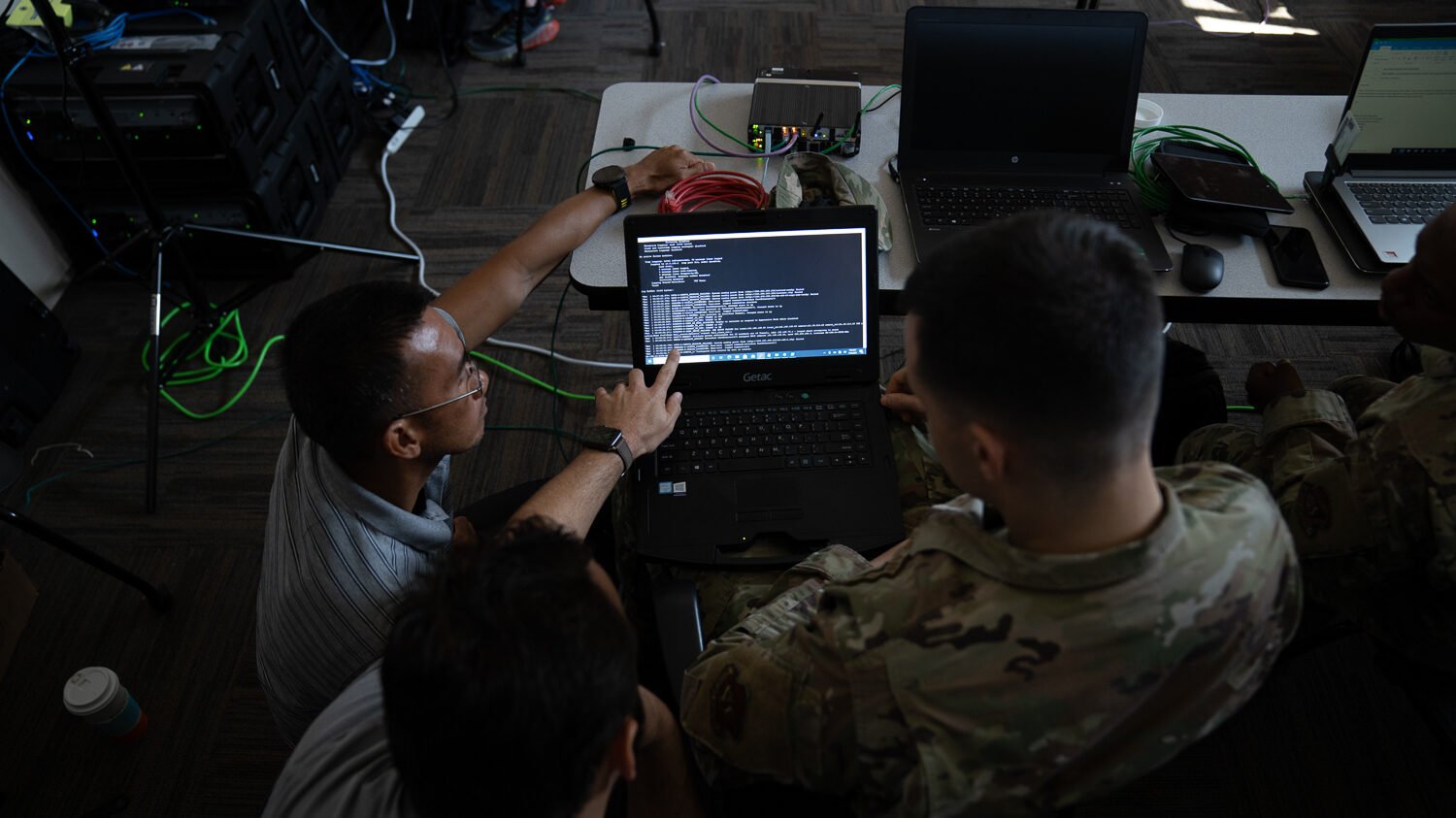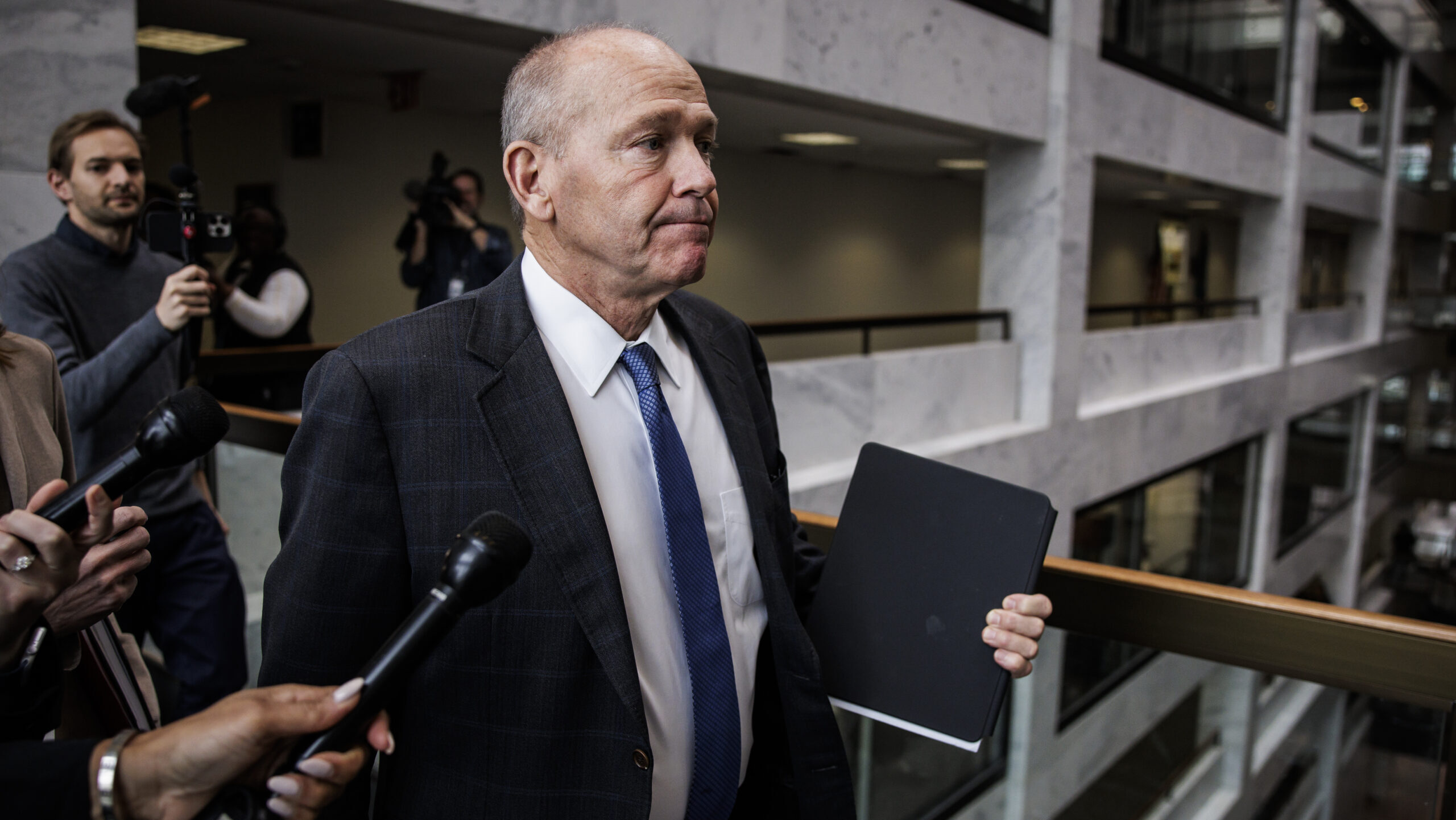
Members of the 56th Air and Space Communications Squadron at Joint Base Pearl Harbor-Hickam operate cyber systems using a Enhanced communications flyaway kit during the Global Information Dominance Experiment 3 and Architect Demonstration Evaluation 5 at Alpena Combat Readiness Training Center, Alpena, Michigan, July, 12, 2021. (U.S. Air Force photo by Tech. Sgt. Amy Picard)
WASHINGTON — After years of effort, the Pentagon has built the first functioning version of its long-sought Combined Joint All Domain Command & Control (CJADC2), an AI-powered meta-network to coordinate all the armed forces across land, sea, air, outer space, and cyberspace, Deputy Secretary Kathleen Hicks said at a CDAO conference this afternoon.
However, it appears the Pentagon is not currently able to actually employ the system, due to the unresolved budget situation in Congress.
Cobbled together from multiple complementary projects — some run by the several armed services and others by the central Chief Digital & AI Office (CDAO) — this version of CJADC2 was put through its paces in December as part of an all-service Global Information Dominance Experiment, GIDE 8.
“CJADC2 isn’t a platform or a single system,” Hicks said. “It’s a fusion of concepts, technologies, policies, tools, and talent.”
“Over the last year, CDAO and its partners have used a series of Gobal Information Dominance Experiments to set a blisteringly fast pace for this work,” the DepSecDef said. “Last August… I had challenged CDAO and its mission partners to deliver a Minimum Viable Capability for CJADC2 by the end of 2023.”
They succeeded, Hicks said: “The Minimum Viable Capability for CJADC2 is real and ready now. It’s low latency and extremely reliable.”
RELATED: Air Force CJADC2 plans ‘completely hamstrung’ by budget impasse, general says
But what is a “Minimum Viable Capability”? The official Pentagon policy [PDF] on the accelerated Software Acquisition Pathway doesn’t actually define that specific term. A “Minimum Viable Product” (a term borrowed from industry) is “an early version of the software to deliver or field basic capabilities to users to evaluate and provide feedback on,” says DoD Instruction 5000.87. But that’s not quite applicable to CJADC2, which as Hicks emphasized is not a single piece of software but an agglomeration.
(The next-closest official term in DODI 5000.87 to “Minimum Viable Capability” is “Minimum Viable Capability Release,” but that indicates something that seems somewhat more advanced that Hicks implied. An MCVR is “the initial set of features suitable to be fielded to an operational environment that provides value to the warfighter or end user in a rapid timeline. The MVCR delivers initial warfighting capabilities to enhance some mission outcomes.”)
Hicks cited “security reasons” for giving no further detail and declined reporters’ followup questions as she hastened from the forum. Pentagon press officers were still working on a query from Breaking Defense as of publication of this article.
Budget Gridlock Impacting Rollout?
Regardless of exactly what the “real and ready… Minimum Viable Capability” is, it seems like the military can’t actually use it yet. That’s not because of any technological problem, but because of budget gridlock in the Congress, which has kept the government operating on stopgap Continuing Resolutions without yet passing proper appropriations for fiscal 2024, which began Oct. 1.
“One of our combatant commanders recently reached out to me noting that the advances that they’re relying on from CDAO are dead in the water without our fiscal year 2024 appropriations,” Hicks said. “So we need Congress to come together and pass appropriations for 2024.
“It is long overdue, and the delay is devastating,” Hicks said. “If you’re an intel analyst in Iran or Russia or China, you’re probably pretty happy right now.”
Hicks’ comments came almost a month after CDAO deputy Margaret Palmieri hinted at the Minimum Viable Capability during a Hudson Institute event on Jan. 24
“We doubled, or more, our budget in [CDAO] from ’23 to ’24,” Palmieri said at a Hudson Institute event on Jan. 24. “[But we] don’t have any access to that funding right now to make that that minimum viable capability truly accessible and robust across the FYDP [Future Years Defense Program].”
“Today, there’s no program of record or POM [Program Objective Memorandum] process change that needs to happen, no additional investment, other than the full appropriation and 24,” she said.
Despite the legislative delay, Palmieri was enthused about the CJAD2 MVC and provided some intriguing details. “The cool thing about GIDE is once you make those connections, inside of experimentation, we are dealing with live data,” she told the Hudson audience. “We are on live networks, [not] modeling.”
In 2023, Palmieri said, “we focused on long-range maritime fires, specifically for the Indo-Pacific. “In GIDE 7, we actually just digitized the targeting data…. Can we go from the combatant command all the way down to the tactical level? Can the, you know, shooter actually [confirm] that they have it? Can they fire weapons off the quality of data that they’ve received?… In GIDE 8, we were able to do the same thing with even more weapons associated with that kill chain.”
This year, “in GIDE 9, we are going to align with a couple exercises the Army’s doing in Project Convergence,” she continued. “We really want to see how the combat commands and the Joint Task Forces now take that [CJADC2] down to a tactical level within a service.”
Like Hicks, Palmieri emphasized that CJADC2 is not a single thing but a federation of capabilities, much of it created by the services rather than CDAO itself. “Minimum Viable Capability is largely a connection of existing capabilities that we have today that have shared data in new ways,” she told the Hudson audience in January. “[We] have brought together a combination of new applications, new data services, with users to create better workflows.”
Michael Marrow and Theresa Hitchens also contributed to this article.












